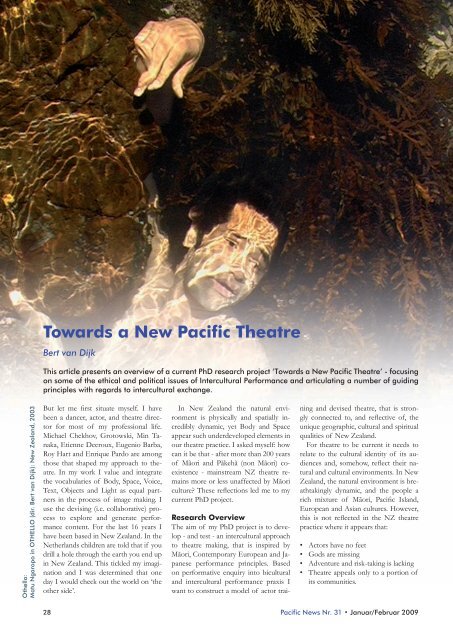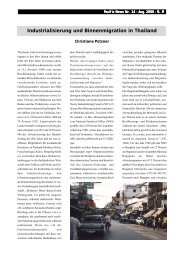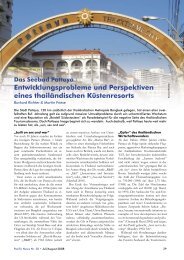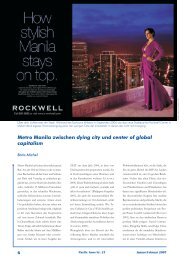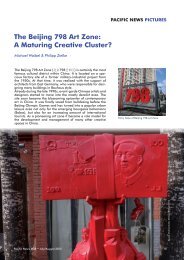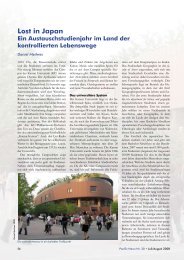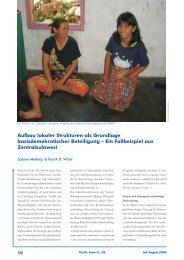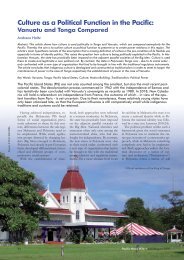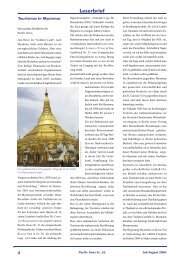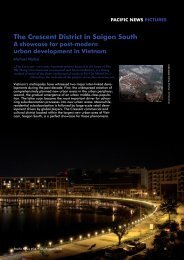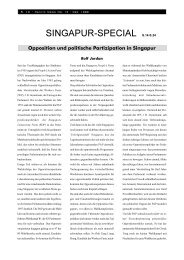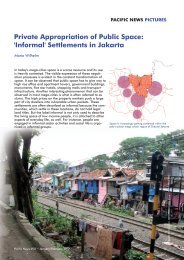Towards a New Pacific Theatre
Towards a New Pacific Theatre
Towards a New Pacific Theatre
You also want an ePaper? Increase the reach of your titles
YUMPU automatically turns print PDFs into web optimized ePapers that Google loves.
<strong>Towards</strong> a <strong>New</strong> <strong>Pacific</strong> <strong>Theatre</strong><br />
Bert van Dijk<br />
This article presents an overview of a current PhD research project ‘<strong>Towards</strong> a <strong>New</strong> <strong>Pacific</strong> <strong>Theatre</strong>’ - focusing<br />
on some of the ethical and political issues of Intercultural Performance and articulating a number of guiding<br />
principles with regards to intercultural exchange.<br />
Othello:<br />
Matu Ngaropo in OTHELLO (dir. Bert van Dijk): <strong>New</strong> Zealand, 2003<br />
But let me first situate myself. I have<br />
been a dancer, actor, and theatre director<br />
for most of my professional life.<br />
Michael Chekhov, Grotowski, Min Tanaka,<br />
Etienne Decroux, Eugenio Barba,<br />
Roy Hart and Enrique Pardo are among<br />
those that shaped my approach to theatre.<br />
In my work I value and integrate<br />
the vocabularies of Body, Space, Voice,<br />
Text, Objects and Light as equal partners<br />
in the process of image making. I<br />
use the devising (i.e. collaborative) process<br />
to explore and generate performance<br />
content. For the last 16 years I<br />
have been based in <strong>New</strong> Zealand. In the<br />
Netherlands children are told that if you<br />
drill a hole through the earth you end up<br />
in <strong>New</strong> Zealand. This tickled my imagination<br />
and I was determined that one<br />
day I would check out the world on ‘the<br />
other side’.<br />
In <strong>New</strong> Zealand the natural environment<br />
is physically and spatially incredibly<br />
dynamic, yet Body and Space<br />
appear such underdeveloped elements in<br />
our theatre practice. I asked myself: how<br />
can it be that - after more than 200 years<br />
of Mãori and Pãkehã (non Mãori) coexistence<br />
- mainstream NZ theatre remains<br />
more or less unaffected by Mãori<br />
culture? These reflections led me to my<br />
current PhD project.<br />
Research Overview<br />
The aim of my PhD project is to develop<br />
- and test - an intercultural approach<br />
to theatre making, that is inspired by<br />
Mãori, Contemporary European and Japanese<br />
performance principles. Based<br />
on performative enquiry into bicultural<br />
and intercultural performance praxis I<br />
want to construct a model of actor training<br />
and devised theatre, that is strongly<br />
connected to, and reflective of, the<br />
unique geographic, cultural and spiritual<br />
qualities of <strong>New</strong> Zealand.<br />
For theatre to be current it needs to<br />
relate to the cultural identity of its audiences<br />
and, somehow, reflect their natural<br />
and cultural environments. In <strong>New</strong><br />
Zealand, the natural environment is breathtakingly<br />
dynamic, and the people a<br />
rich mixture of Mãori, <strong>Pacific</strong> Island,<br />
European and Asian cultures. However,<br />
this is not reflected in the NZ theatre<br />
practice where it appears that:<br />
• Actors have no feet<br />
• Gods are missing<br />
• Adventure and risk-taking is lacking<br />
• <strong>Theatre</strong> appeals only to a portion of<br />
its communities.<br />
28<br />
<strong>Pacific</strong> <strong>New</strong>s Nr. 31 • Januar/Februar 2009
I propose a <strong>New</strong> <strong>Pacific</strong> <strong>Theatre</strong> that<br />
is cutting-edge, experimental, embracing<br />
the latest technologies and theatre<br />
expertise, as well as being deeply rooted<br />
in the spiritual and cultural dimensions<br />
of <strong>Pacific</strong> tradition - its actors connected<br />
with their body and the earth (They<br />
Have Feet), the archetypal qualities of<br />
the gods incorporated in training and<br />
performance practice (Return of the<br />
Gods), a sense of adventure prominent,<br />
and relating to our various cultures and<br />
communities.<br />
For pragmatic reasons, it has been necessary<br />
to narrow the field of my inquiry<br />
to a definite number of praxis within<br />
each of the fields of Mãori, Japanese and<br />
Contemporary European Performance.<br />
Within the field of Mãori performing<br />
arts I am concentrating on the pre-European<br />
form of Te Whare Tapere. The<br />
reasons for this are three-fold:<br />
1. To circumnavigate the complex issue<br />
of colonialism that has influenced<br />
current Mãori theatre practice in ways<br />
that makes it hard to establish what is<br />
essentially Mãori, and what is Pãkehã<br />
based<br />
2. Having access to the in-depth research<br />
on Te Whare Tapere by Dr Charles<br />
Royal, undertaken in the context of<br />
his PhD research at VUW (1998)<br />
3. A strong personal and professional<br />
attraction to the performance principles<br />
and value-base of Te Whare Tapere:<br />
Manaakitanga (reciprocal relationships),<br />
Rangatiratanga (leadership<br />
through unity), Tohungatanga (knowledge<br />
of symbols), Ûkaipo (spiritual<br />
nourishment), Whanaungatanga (inter-connectedness<br />
of all things in the<br />
world) and Kotahitanga (unity of all<br />
things).<br />
Within the diverse field of Japanese<br />
performance the spotlight is on the two<br />
contrasting genres of Nõ and Butoh.<br />
Nõ <strong>Theatre</strong> is one of the oldest theatre<br />
genres in the world that has stayed alive<br />
for many centuries in more or less the<br />
same form. It is still possible to observe<br />
Nõ training and performance in action.<br />
The Nõ philosophy and practice are well<br />
documented in the English language,<br />
and a number of NZ theatre practitioners<br />
have incorporated elements of Nõ<br />
in their work. In contrast Butoh is a contemporary,<br />
rebellious response to some<br />
of the formal and restrictive aspects of<br />
traditional Japanese society and theatre<br />
practice. It offers an exciting example of<br />
intercultural performance in which Western<br />
and Japanese codes and expressions<br />
coexist and collide.<br />
In the domain of Contemporary European<br />
Performance I am focusing on<br />
Devised or Collaborative <strong>Theatre</strong>, the<br />
Michael Chekhov Technique, and Intercultural<br />
Performance. Devised <strong>Theatre</strong><br />
is one of the most effective strategies to<br />
deal with the ethical, political, and spiritual<br />
complexities of intercultural performance.<br />
It offers a number of ways<br />
for cultural identities and environmental<br />
qualities to inform the creative process:<br />
Firstly, the collaborative nature of Devised<br />
<strong>Theatre</strong> allows an ensemble, made<br />
up of artists from various cultural backgrounds,<br />
to incorporate ideas, values and<br />
modes of expression that are culturally<br />
formed (in <strong>New</strong> Zealand: Mãori, <strong>Pacific</strong><br />
Island, European and Asian).<br />
Secondly, devisers aim to create performances<br />
that are current. This implies<br />
that the performance material is somehow<br />
reflective of, and connected to,<br />
the people and their environment.<br />
Thirdly, devisers are committed to experimentation,<br />
exploring a wide range<br />
of possible locations in the natural and<br />
urban environments as a site for performance.<br />
The Michael Chekhov Technique - recently<br />
experiencing a huge international<br />
revival - enables the actor to draw from<br />
their body and imagination in order to<br />
create intention, feeling and quality of<br />
being (character). It beautifully balances<br />
the demands of form and content<br />
in theatrical expression. When aiming to<br />
bring together a number of theatre practices<br />
from various cultural ancestries, we<br />
are entering the domain of Intercultural<br />
Performance – an arena fraught with<br />
ethical and political issues. In <strong>New</strong> Zealand<br />
the unique relationship between<br />
Mãori and Pãkehã has crystallised the intercultural<br />
performance debate on issues<br />
of bi-cultural theatre.<br />
Agamemnon:<br />
Matariki Whatarau as Agamemnon in<br />
AGAMEMNON<br />
(dir. Bert van Dijk): <strong>New</strong> Zealand, 2005<br />
Intercultural Performance<br />
Debate<br />
On reviewing the ideas of Rustom Bharucha<br />
(1993), Christopher Balme (2007),<br />
Charles Royal (1998) and Janinka Greenwood<br />
(2002), it appears that the intercultural<br />
performance debate centres on the<br />
following issues:<br />
a) Globalisation and Diasporas<br />
b) The relationship between tangible<br />
and intangible aspects of cultural expressions<br />
(in other words: matters of<br />
form and content)<br />
c) The appropriation of cultural material<br />
d) Mutuality in relationships during the<br />
process of intercultural exchange.<br />
Issues of Globalisation:<br />
In her article Researching the Native<br />
Mãori (Norman & Lincoln, 2005) Linda<br />
Tuhiwai Smith observes that the current<br />
globalisation carries in it a danger of<br />
loosing the culturally specific.<br />
“For indigenous communities, the<br />
“something lost” has been defined as<br />
indigenous knowledge and culture.<br />
In biological terms, it is our diversity;<br />
in sociolinguistics, it is the diversity<br />
of minority languages; culturally, it is<br />
our uniqueness of stories and experiences<br />
and how they are expressed.”<br />
(p. 95)<br />
Across the globe our cities are starting<br />
to look more and more the same - containing<br />
similar food and drinking outlets,<br />
manifesting ‘a sameness’ in architecture,<br />
and using English as the main language.<br />
For some people it is comforting to<br />
<strong>Pacific</strong> <strong>New</strong>s Nr. 31 • Januar/Februar 2009<br />
29
know that - no matter where you are in<br />
the world - you can get your latte, your<br />
Big Mac, or your favourite Italian food.<br />
Others deeply regret and resent these<br />
homogenizing developments, and long<br />
for authentic cultural encounters when<br />
travelling.<br />
The increased mobility of people<br />
across geographic borders also presents<br />
an opportunity for people to connect<br />
across cultural differences, and to learn<br />
from, and appreciate, these differences. I<br />
argue that Intercultural Performance can<br />
play a significant role in the survival of<br />
the culturally specific (language, cultural<br />
expressions, values) as well as enriching<br />
the palette of our artistic experiences.<br />
Some people respond to things foreign<br />
or ‘other’ with a feeling of fear or<br />
terror (Xenophobia), while others are attracted<br />
and fascinated, perhaps even obsessed<br />
by the ‘other’. For me, the attraction<br />
to ‘otherness’ (Xenophoria) is what<br />
drives me to travel, to engage with other<br />
beings, other cultures, and other practices.<br />
It is what expands my horizons,<br />
and deepens my understanding of how<br />
people and communities operate and express<br />
themselves. To give theatrical expression<br />
to this strong drive in me I created<br />
a solo performance in the mid 90’s,<br />
directed by Enrique Pardo. For the title<br />
of this show I invented a new word: XE-<br />
NOPHORIA<br />
This word fuses the linguistic roots of<br />
Xeno (foreigner) and Euphoria (ecstasy)<br />
into ‘the ecstatic love of all things foreign’.<br />
Tangible and intangible aspects of cultural expressions:<br />
The discussions around the appreciation<br />
of tangible and intangible aspects<br />
of cultural expression - particularly concerning<br />
issues of universality versus the<br />
culturally and historically specific - are<br />
rather complex and, at times, distorted<br />
by personal or professional bias. In her<br />
monograph History of Bicultural <strong>Theatre</strong><br />
Janinka Greenwood (2002) observes<br />
that the theatre of cultural exchange, as<br />
explored by Brook, Barba and Grotowski,<br />
is more concerned with theatrical<br />
form than with the complex meanings<br />
those forms carry in their original contexts.<br />
In this context she notes that:<br />
“[Bharucha’s writings] have problematised<br />
practices of intercultural<br />
borrowing and the understanding of<br />
both theatre and culture that underlie<br />
them. At the base of Bharucha’s critique<br />
is an insistence that “bios” cannot<br />
be separated from “ethos”; that<br />
stories and forms cannot be separated<br />
from the meanings they hold for<br />
their own people, without doing violence<br />
to both the forms and the people.”<br />
(p. 8)<br />
It appears that Bharucha (1993) is more<br />
interested in the culturally specific than<br />
in the universal when he declares:<br />
“There are no universal values<br />
in theatre. There are only personal<br />
needs, which get transformed into<br />
social and political actions, rooted in<br />
the individual histories of theatre.”<br />
(p. 67)<br />
I want to counter this declaration by observing<br />
that many audiences have been<br />
able to enjoy and appreciate performances<br />
based on cultural expressions and<br />
codes foreign to their own. This demonstrates<br />
that theatre contains and reflects<br />
universal values, as well as the socially,<br />
politically and historically specific.<br />
In terms of actor training, it is crucial for<br />
an actor to develop the ability to shape<br />
physical and vocal actions beyond cultural<br />
conditioning. It would be extremely<br />
limiting if an actor were only able to express<br />
the culturally specific - unable to<br />
achieve some kind of neutrality or universality,<br />
from which to transform into<br />
any chosen quality or state of being.<br />
An Example of Cultural Appropriation:<br />
When I saw Peter Brook’s Mahabharata<br />
in Paris (in 1986) I enjoyed the visual<br />
spectacle of this 8-hour long production<br />
with its stunning use of costumes,<br />
fire, water, fight scenes, and imagery. As<br />
I was unfamiliar with the source material,<br />
the intrinsic meanings and context<br />
of the stories went over my head.<br />
After reading Bharucha’s argument<br />
that this show was “one of the most<br />
blatant and accomplished appropriations<br />
of Indian culture in recent years”<br />
(Bharucha 1993), I came to realise that I<br />
had been rather naïve in my original response,<br />
and that Peter Brook’s production<br />
was unethical in a number of ways.<br />
Bharucha compares Brook’s Mahabharata<br />
with the process of commercial textile<br />
exploitation:<br />
i. Raw materials (the story) were taken<br />
from India<br />
ii. These materials were transformed<br />
into commodities (costumes, props, a<br />
text decontextualised from its history<br />
in order to sell)<br />
iii. Sold (forcibly) to India<br />
What is the point of an international<br />
ensemble, Bharucha asks, when most of<br />
the actors’ voices have been homogenised<br />
within a Western structure of action,<br />
and where they have to speak in a<br />
language foreign to them?<br />
Mutuality in Relationships During<br />
Intercultural Exchange:<br />
At the heart of Bharucha’s critique on<br />
intercultural performance practice is his<br />
observation that there is often a lack of<br />
mutuality in relationship during the pro-<br />
30 <strong>Pacific</strong> <strong>New</strong>s Nr. 31 • Januar/Februar 2009
The Blue Shawl: From the left: Tia Barrrett, Tema Kwan Fenton-Coyne,<br />
Ngahuia Murphy (Noh Chorus in the background) in THE BLUE SHAWL<br />
(written / directed John G. Davies): Hamilton, 2008<br />
cess of cultural exchange, particularly in<br />
the context of colonialism. Colonialism<br />
does not operate through exchange: rather<br />
it appropriates, decontextualises, and<br />
represent the ‘other’ culture, often with<br />
the complicity of its colonial subjects.<br />
Guiding Principles for<br />
Intercultural Exchange:<br />
It is impossible within the scope of this<br />
article to cover all the issues of intercultural<br />
performance. To conclude I would<br />
like to articulate a number of guiding<br />
principles with regards to intercultural<br />
exchange.<br />
1. Consider and absorb the original cultural<br />
and historical context of the material<br />
or stories that you are using as<br />
you point of departure<br />
2. Ensure that your working relationships<br />
are mutually beneficial, and that<br />
there is equal pay amongst the collaborating<br />
artists<br />
3. When working with an international<br />
or intercultural ensemble of actors<br />
allow the performers to use their first<br />
tongue and their native performance<br />
codes, and cultural expressions<br />
4. Through the use devising and collaborative<br />
strategies allow each artist a<br />
voice in the exploration and generation<br />
of performance material<br />
The Blue Shawl:<br />
The Blue Shawl (2008) is a recent <strong>New</strong><br />
Zealand intercultural performance that<br />
is exemplary in the way it adhered to the<br />
fore-mentioned guidelines. The show is<br />
giving the Mãori perspective on a historical<br />
event - wrapped in a poetic narrative<br />
- and presented within the structure<br />
and staging conventions of a Nõ Play,<br />
incorporating Kapahaka (Mãori performing<br />
arts) expressions, using both Mãori<br />
and English language, with a mixed cast<br />
of Mãori and Pakeha performers, and<br />
accompanied by Taonga Puoro (traditional<br />
Mãori musical instruments), a small<br />
Taiko Drum and Nohkan (a Japanese<br />
flute).<br />
The original historical incidents were<br />
considered and absorbed within their<br />
cultural context by writer / director<br />
John Davies. Permission to tell this story<br />
was obtained beforehand, and the performance<br />
material was developed in ongoing<br />
partnership and consultation with<br />
a close relative of the protagonist of the<br />
initial story. Throughout the writing and<br />
rehearsal process John consulted the appropriate<br />
Kaumatua (Mãori elders) in<br />
matters of Te Reo (Mãori language) and<br />
Tikanga Mãori (Mãori protocol). All the<br />
artists, involved in this project, participated<br />
on a voluntary basis, motivated by a<br />
deep commitment to tell this particular<br />
story, a strong desire to work with the<br />
director, or both. The Mãori performers<br />
were able to use Te Reo as well as English;<br />
they were encouraged to incorporate<br />
Mãori codes and expressions, such<br />
as Mãori footwork, wiriwiri (fluttering<br />
of the hands), pukana (facial animation),<br />
waiata (song), haka (dance), and Mãori<br />
actions.<br />
As the director, John is committed to<br />
creating the right atmosphere and circumstance<br />
that invite the appropriate response<br />
from the performers. He places<br />
huge value on the contribution of each<br />
individual, and allows room for experimentation<br />
and error. As such he employs<br />
devising strategies that allow each<br />
participating artist to have a voice in the<br />
ultimate performance.<br />
Final Quote:<br />
“If inter-culturalism is born through<br />
the meeting of ‘self’ and the ‘other’,<br />
the real challenge is to maintain<br />
the reciprocity of this dynamic“<br />
(Bharucha 1993: 155)<br />
Bibliography<br />
Balme, Christopher B. <strong>Pacific</strong> Performances: Theatricality<br />
and Cross-Cultural Encounter in the South Seas. London:<br />
Palgrave Macmillan, 2007.<br />
Bharucha, Rustom. <strong>Theatre</strong> and the World: Performance<br />
and the politics of Culture. London & <strong>New</strong> York: Routledge,<br />
1993.<br />
Denzin, Norman K. & Yvonna Lincoln. The Sage<br />
Handbook of Qualitative Research. London & <strong>New</strong> Delhi:<br />
Sage Publications, Inc., 2005.<br />
Greenwood, Janinka. History of Bicultural <strong>Theatre</strong><br />
– Mapping the terrain. Research Monograph Series,<br />
Christchurch, 2002.<br />
Haseman, Brad. A Manifesto for Performative Research.<br />
Media International Australia incorporating Culture and<br />
Policy, theme issue "Practice-led Research" (no. 118): pp.<br />
98-106, 2006.<br />
Maufort, Marc & David O’Donnell (eds.). Performing<br />
Aotearoa: <strong>New</strong> Zealand <strong>Theatre</strong> and Drama in an Age<br />
of Transition. Brussels: P.I.E. Peter Lang S.A., 2008.<br />
Royal, Charles. Te Whare Tapere. Wellington: Department<br />
of <strong>Theatre</strong> and Film, VUW, PhD thesis, 1998.<br />
Van Dijk, Bert. Devised <strong>Theatre</strong>: A Devising Model.<br />
eBook: www.theater-tools.com, 2006.<br />
Van Dijk, Bert. Practical Exercises for Devisers. eBook:<br />
www.theater-tools.com, 2007.<br />
Bert van Dijk [bertvd@clear.net.nz] is a Dutch-born theatre pedagogue and director, who directed<br />
numerous productions in a great variety of genres: classics, devised theatre, mime, physical, bi-cultural,<br />
inter-cultural, musical, community and outdoor theatre. He is currently a PhD student at the Victoria<br />
University of Wellington and a lecturer at Whitireia Polytechnic.<br />
He has an own website: www.theater-tools.com<br />
<strong>Pacific</strong> <strong>New</strong>s Nr. 31 • Januar/Februar 2009<br />
31


